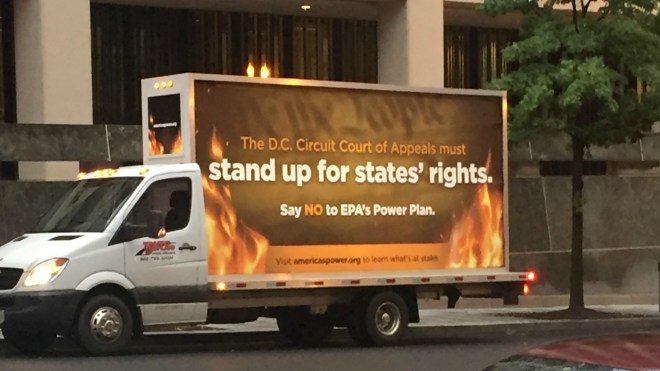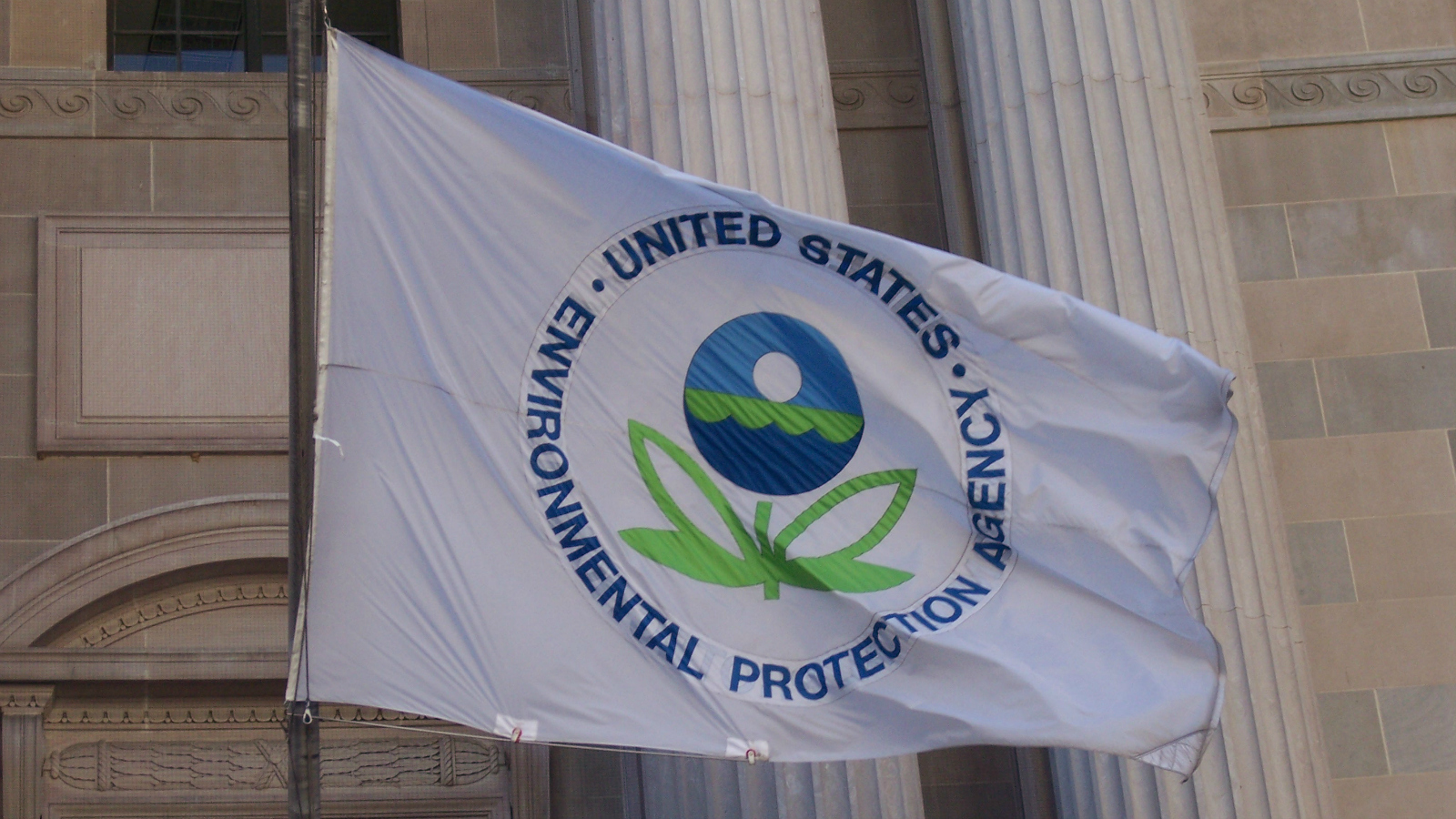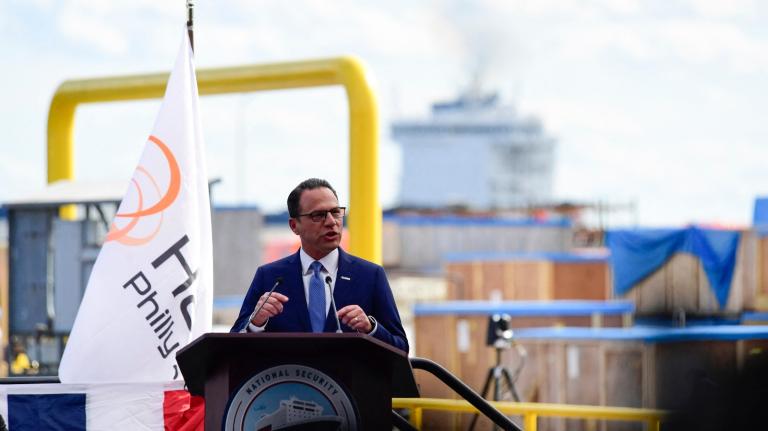You probably thought that last week’s only notable debate was the one between Hillary Clinton and Donald Trump at Hofstra University, but, on Tuesday, supporters and opponents of EPA’s Clean Power Plan had a high-stakes showdown of their own in Washington, D.C.: a seven-hour oral argument before the D.C. Circuit Court of Appeals. The proceedings may not have spawned an SNL sketch, but in the wonky world of environmental law, they were a very big deal.
“Everyone will be there,” my colleague wrote a few days before the hearing, explaining why it was totally worth it to give up my ticket to see Adele at Madison Square Garden and instead take a train to Washington so I could line up at 6:00 a.m. to get into a courtroom.
And everyone (except Adele) was there: politicians and activists, academics and journalists, lobbyists and executives, the people who lobbyists and executives pay to stand in line for them so they can sleep in (actually a thing), a guy driving a truck with a burning constitution painted on it, a ton of lawyers, and, most importantly, 10 of the nation’s fanciest judges.

Truck with burning constitution.
If you think that sounds like a lot of judicial firepower for a single hearing, you’re right. Typically, cases before the D.C. Circuit are heard by a three-judge panel, at least initially. But, for this suit, the court took the very unusual step of skipping straight to en banc review, which means that all of the circuit’s active judges get a say in the outcome — except Chief Judge Merrick Garland, who has recused himself from D.C. Circuit matters while his nomination to the Supreme Court is pending. (Remember that time the president nominated someone to the Supreme Court and Senate Republicans refused to give him a confirmation hearing? He’s still waiting.)
The basics
Before diving into the details of the argument, a refresher on the rule at issue: “Clean Power Plan” is EPA’s shorthand for a set of federal guidelines, issued under the Clean Air Act, that limit carbon dioxide emissions from the nation’s existing (as opposed to newly constructed) power plants. Based on these guidelines, states are expected (but not required) to design customized compliance plans for plants within their borders. If a state declines to submit a plan, EPA will step in to regulate that state’s plants directly.
By 2030, the Clean Power Plan is projected to reduce the power sector’s carbon emissions to 32 percent below 2005 levels. This is slightly less impressive than it sounds, because the sector already emits 21 percent less carbon than it did in 2005, meaning it’s already two-thirds of the way to compliance. Nevertheless, the plan is widely regarded as the most important environmental initiative of the Obama presidency.
EPA proposed the Clean Power Plan in June 2014 and finalized it in August 2015. State implementation proposals were originally set to be due last month, but, in February, five justices of the Supreme Court voted to stay the plan — that is, suspend its implementation — pending the resolution of the lawsuit against it. The suit, by the way, involves a huge number of parties. Twenty-seven states, along with a number of coal companies and coal-dependent utilities, are allied against the plan. Eighteen other states — plus seven municipalities, more than a dozen environmental organizations, and a different set of utilities and industry groups — have intervened to support it. (A disclosure: While my employer, the Institute for Policy Integrity at New York University School of Law, is not a party in the case, it did file a “friend of the court” brief in support of EPA, which I coauthored.)
The nitty-gritty
OK, on to the wonkery: What exactly did all of those parties argue about at this oral argument? Well, a lot of things (again, it was a seven-hour hearing; most cases before the D.C. Circuit get 20 minutes), but here are two of the most significant issues discussed:
1. Double trouble
EPA issued the Clean Power Plan under a 46-year-old provision of the Clean Air Act called Section 111(d). (I promise that is the only section number I will use in this post. Stay with me!) Section 111(d) empowers the agency to regulate existing “stationary sources” of pollution — like power plants — in a limited set of circumstances. As originally passed in 1970, Section 111(d)’s parameters were crystal clear: It applied whenever the pollutant being regulated wasn’t already regulated as a “criteria” pollutant (a category that includes soot and smog precursors like sulfur dioxide and nitrogen oxides) or a “hazardous” pollutant (a category that includes “air toxics” like mercury and benzene).
In 1990, however, Congress passed a bunch of amendments to the Clean Air Act with the goal of strengthening the law and, as part of the process, tweaked Section 111(d). Unfortunately, the wording of an amendment that originated in the House differed from that of an amendment that originated in the Senate. Even more unfortunately, the conference committee charged with reconciling the House and Senate bills overlooked the conflict. So the final bill passed by both houses of Congress and signed into law by President George H.W. Bush contained, essentially, two versions of Section 111(d).
Under the Senate amendment, it remains clear that EPA can use Section 111(d) to regulate pollution from existing sources whenever the pollutant in question isn’t already regulated as a criteria or hazardous pollutant. This framing doesn’t pose a problem for the Clean Power Plan, because carbon dioxide — the pollutant that the Clean Power Plan regulates — isn’t already regulated under the criteria or hazardous pollution programs.
The wording of the House amendment is murkier. The Clean Power Plan’s opponents read it to bar EPA from regulating a type of source under Section 111(d) if that source type is already regulated under the hazardous pollutant program. This framing would cause trouble for the Clean Power Plan, because, although EPA doesn’t already regulate power plants’ carbon emissions under the hazardous pollutant program, it does regulate their mercury emissions under that program.
But at Tuesday’s hearing, a majority of the judges seemed skeptical of the challengers’ interpretation of Section 111(d). They questioned why the court should prioritize the House amendment over the Senate amendment, rather than attempting to give effect to both or, if that proved unworkable, throwing out both and returning to the pre-1990 status quo. They also pointed out that the House amendment itself is hardly a model of clarity and that the challengers’ interpretation is not the only plausible reading of it. Typically, when statutory language is ambiguous, a court will defer to any reasonable interpretation offered by the agency. And here, the EPA does not interpret the House amendment to bar the Clean Power Plan.
The judges also noted that there was little evidence that either chamber of Congress actually intended to limit EPA’s Section 111(d) authority in the seemingly absurd fashion posited by the challengers. Why, in a statute designed to protect public health from dangerous air pollution in all forms, would Congress force EPA to choose between regulating power plants’ emissions of mercury and carbon, both of which the agency knows to be harmful?
The challengers reasoned that the 1990 Congress didn’t want facilities subjected to “double regulation,” but Judge Cornelia Pillard questioned the accuracy of that terminology given that the agency’s two rules were aimed at two different harms. We don’t, she observed, in one of the day’s most memorable judicial quips, consider it “double regulation” to require a driver to both stay in his lane and observe the speed limit.
2. Talkin’ ’bout my generation
The next issue before the court was not a question of whether the EPA could regulate carbon emissions from existing power plants, but one of how the agency could go about regulating those emissions. Section 111(d) requires EPA to base the stringency of its emission guidelines on the “best system of emission reduction” for the relevant pollutant and source type. Importantly, when complying with a Section 111(d) rule from EPA, states don’t actually have to use the “best system” identified by the agency; they just have to do something that will cut pollution by at least the same amount. The “best system” is essentially the agency’s way of saying, “If these were my plants, here’s what I’d do to reduce their emissions.”
In the Clean Power Plan, EPA identified the “best system” of reducing carbon dioxide from power plants as a combination of three “building blocks”: (1) improving the “heat rate” of coal plants — that is, the efficiency with which they convert coal to electricity; (2) substituting increased generation at lower-emitting natural gas plants for reduced generation at higher-emitting coal plants; and (3) substituting increased generation from zero-emitting renewable sources for reduced generation from both coal and gas plants. In other words, EPA concluded that the best way to reduce carbon pollution from power plants was for states to make their dirty sources a bit less dirty and use their cleaner sources more often.
The challengers don’t have a problem with the first block — improving the efficiency of coal plants — but they argue that the second and third blocks don’t qualify as a “system of emission reduction” because they rely on shifting generation from one plant to another rather than reducing the rate at which each individual plant emits carbon (through, say, the installation of new, on-site technology). EPA, meanwhile, contends that generation shifting is absolutely a “system of emission reduction,” and a uniquely appropriate one for cutting carbon from power plants due to the interconnected nature of the electric grid, which makes it easy to substitute generation from one source for another, and the fact that carbon is a global pollutant, which means that a reduction in emissions offers the same climate benefit regardless of where it occurs.
As explained earlier, when a statutory phrase — like “best system of emission reduction” — is ambiguous, a court typically defers to any reasonable interpretation offered by a government agency. But there is a rarely used exception to this deferential standard, which applies when an agency’s rule represents an “enormous and transformative” expansion of its authority. In those cases, a reasonable interpretation of ambiguous language does not suffice; instead, the agency must point to a clear statement from Congress authorizing its actions.
The challengers, unsurprisingly, argued at the hearing that setting carbon standards based on generation shifting represents an “enormous and transformative” expansion of EPA’s power. But EPA and its supporters cited quite a bit of evidence to the contrary. For one thing, the agency has previously taken the possibility of generation shifting into account when regulating other pollutants from the power sector, such as in its 2011 Cross-State Air Pollution Rule, which was upheld by the Supreme Court. And even when EPA based past standards on the assumption of an on-site technological fix, as in its 2012 mercury rule, plant owners often chose to comply through generation shifting anyway. Why? Because it was cheaper.
As with mercury, there are on-site technological options for reducing carbon emissions from power plants, but they’re more expensive. Thus, even if EPA did base its Clean Power Plan guidelines on an assumption that coal plants would, say, retrofit to co-fire with natural gas or install carbon-capture-and-storage systems, plant owners would inevitably end up satisfying those guidelines by engaging in generation shifting. In fact, it’s what they’re already doing to comply with state and regional carbon-reduction programs, like the Northeast’s Regional Greenhouse Gas Initiative.
Ultimately, as Kevin Poloncarz, a lawyer for power companies that support the Clean Power Plan, pointed out, the challengers’ argument boils down to this: When choosing a “best system” for reducing power plants’ carbon emissions, EPA must ignore what it knows the power sector will actually do to reduce carbon emissions. But the agency isn’t required to live in this “make-believe world,” Poloncarz insisted, and a majority of the judges seemed inclined to agree.
The bottom line
Overall, it was a good day in court for the Clean Power Plan (and you don’t have to take my word for it — even The Daily Caller agrees). But the result won’t be certain until the D.C. Circuit issues a written decision, which will take months. And then there’s the inevitable Supreme Court appeal to worry about. One thing I am sure of? The line for that hearing will be even longer.
——
Jack Lienke is a senior attorney at the Institute for Policy Integrity and a coauthor, with Richard L. Revesz, of Struggling for Air: Power Plants and the “War on Coal.” Follow him on Twitter at @jacklienke.



